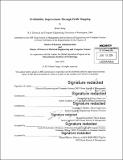Profitability improvement through profit mapping
Author(s)
Chang, Brian, S.M. Massachusetts Institute of Technology
DownloadFull printable version (6.339Mb)
Other Contributors
Leaders for Global Operations Program.
Advisor
George Kocur and Jonathan L. Byrnes.
Terms of use
Metadata
Show full item recordAbstract
Faced with a dynamically changing market, Boston Scientific's Cardiac Rhythm Management is seeking ways to increase its profitability. The division is experiencing a phenomenon where pulse generators and leads' product life cycle transitions may be slower than ideal. In addition, Boston Scientific is exploring ways to systematically and accurately assess its products' return on investments. The approach to the project is a technique called Profit Mapping. By carefully assessing the true full costs of each transaction, we can determine the actual profitability of each account and product and use the visualized results to detect anomalies, test hypotheses, and formulate action plans. The profit mapping tool allows us to compare profitability within each dimension of the business-individual product, account, sales person, territory, contract group, therapy system, or any combination of multiple dimensions. When we group data by accounts, we discover accounts that generate much higher profit than accounts that have higher revenue. Profit Map also shows some products or therapies traditionally believed to be unprofitable are actually high profit earners. Furthermore, time analysis of account profit maps revealed accounts whose revenue has been on the decline but profit on the rise thanks to transition in product mix. The delivery of the framework and its methodology concludes my internship but is only the beginning of Boston Scientific's journey to increase profitability. The Finance Department can now combine Profit Mapping data with the Sales Operations Department's experience and instincts to identify best practices that contribute towards higher revenue dollar efficiency, re-align sales incentives with company's profitability, and re-evaluate the opportunity cost of maintaining a marginal or net-loss account/product. In the long run, Profit Mapping can be scaled up to analyze world-wide data from all divisions to provide a clearer path to profitability.
Description
Thesis: M.B.A., Massachusetts Institute of Technology, Sloan School of Management, 2014. In conjunction with the Leaders for Global Operations Program at MIT. Thesis: S.M., Massachusetts Institute of Technology, Department of Electrical Engineering and Computer Science, 2014. In conjunction with the Leaders for Global Operations Program at MIT. Cataloged from PDF version of thesis. Includes bibliographical references (pages 56-57).
Date issued
2014Department
Leaders for Global Operations Program at MIT; Massachusetts Institute of Technology. Department of Electrical Engineering and Computer Science; Sloan School of ManagementPublisher
Massachusetts Institute of Technology
Keywords
Sloan School of Management., Electrical Engineering and Computer Science., Leaders for Global Operations Program.